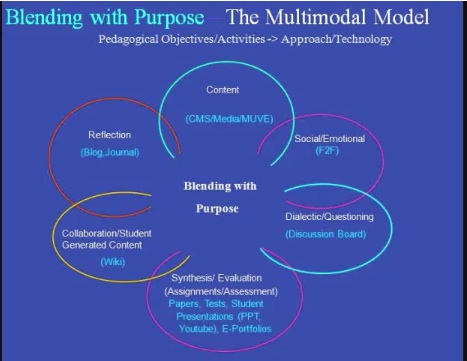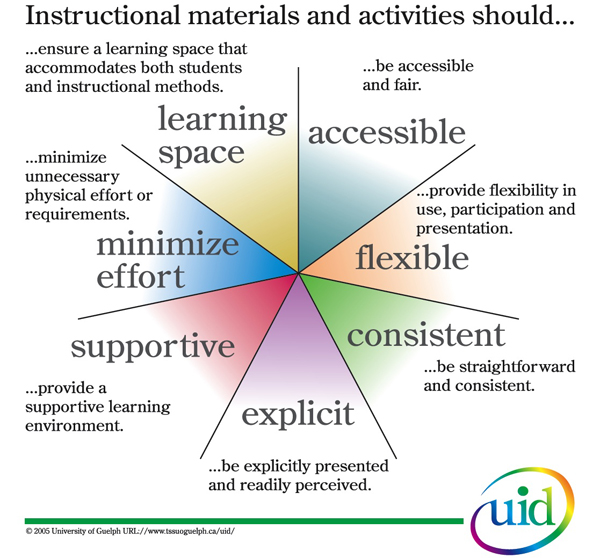Multimodal Teaching and Learning
Multimodal Use of Media and Students
Multimodal Teaching incorporates variations of learning styles into the development of course materials and delivery. According to a recent report commissioned by networking and communications company, Cisco Systems, results of students surveyed concluded that “students tend to learn more when taught through multiple modes and media rather than in just a single mode.” The 2009 report, Multimodal Learning Through Media: What the Research Says compiled by the Metiri Group, an education-consulting firm, based their findings on information collected from nearly 6000 students who participated in the study.
From the Cisco study of multimodal learning and multimedia, five strategic rules were determined as valid outcomes.
- Save Interactivity for Complex Subjects
- Avoid Too Many Inputs
- Keep Lessons Focused
- Reinforce Relationships
- Treat multimedia as a means, not an end
This video, Blending with Purpose: The Multimodal Model, was created by Anthony Picciano of Hunter College and Graduate Center. The video captures a multimodal conceptual model for designing and developing blended learning courses and programs. Click on the image below to access the video:

Technology should not be a hindrance to the learning process but should enhance the curriculum as an accompaniment to the subject matter core content. When delivering course content through multimedia formats it is critical to allow technology to act as an asset for the user, not a frustration. If the learner has difficulties with accessing the content, then technology acts as a barrier.

The figure shown above addresses research conducted by Charles Fadel of CISCO and demonstrates the impact of Multmodal learning compared to traditional learning.
Learning Styles
Considering the variations of learning styles among students is a critical factor in the development of multimodal learning content. Identifying and understanding the diverse learning styles of students can better direct content creators to think broadly in their construction of course materials. Incorporating the qualities of these learning styles and addressing the learner’s needs for visual, auditory, tactile, and sociological engagement helps bridge the gap between “traditional” teaching and multimodal teaching. Considering the variations among the qualities associated to learning styles better informs the instructor in the creation of content that meets the needs and achieves the assigned learning goals.
Characteristics of learning styles:
· Auditory learners respond to class discussion and lectures, sounds, music and rhyme
· Visual and spatial learners prefer visual stimulation through the use of images, colors, graphics and other visual media
· Tactile and kinesthetic learners provide hands on opportunities and physical activities
· Verbal learners prefer written text and spoken words to deliver their content
· Social/interpersonal learners communicate well both verbally and non-verbally
· Solitary/intrapersonal learners are private and independent, traditionally learners who prefer to spend time alone as opposed to group efforts
Universal Design and Multimodal Teaching
A core concept of Universal Design for Learning (UDL) is to create content that is accessible to all individuals. UDL is aligned with multimodal teaching as both maintain goals of meeting the needs of all people. The term universal design was created by Ronald L. Mace, founder of The Center for Universal Design. According to Mace, "universal design is the design of products and environments to be usable by all people, to the greatest extent possible, without the need for adaptation or specialized design.”
There are seven principles of Universal Instructional Design (UID):

Principal two of Universal Design encompasses the theory behind multimodal teaching and learning. Learning is most effective when it is multimodal – when material is presented in multiple forms, and when students have multiple means of accessing and interacting with material and demonstrating their knowledge (Palmer, 2003).
References
BNET. Retrieved May 5, 2009, from Using multi-modal techniques to motivate intuitive and non-intuitive students Web site:
CISCO. (2008). Multimodal Learning Through Media: What the Research Says. Retrieved May 14, 2009, from
Moreno, Roxana (2000, October). A Learner-Centered Approach to Multimedia Explanations: Deriving Instructional Design Principles from Cognitive Theory.
IMEJ of Computer-Enhanced Learning, Volume 2, Retrieved May 2009, from:
Multiple Intelligences and Learning Styles in the Classroom (2004). Retrieved May 10, 2009, from Constructivism Knowledge Building in the Secondary Classroom Web site:
Palmer, Jaellayna (2003). Retrieved May 10, 2009, from The Universal Instructional Design Implementation Guide Web site:
Principles of Universal Design (2008). Retrieved May 5, 2009, from The Center for Universal Design Web site:
Comments (0)
You don't have permission to comment on this page.